Teens Fiction App Where Teen Upload Stories

How We Got 10 Million Teens to Read Fiction on Their Phones
The story of Hooked
Three years agone, I was living in a pocket-size surf boondocks in Republic of costa rica and writing my offset novel, when I had a panic set on.
The novel was a sci-fi fantasy trilogy for immature adults, set in Silicon Valley a hundred years in the futurity. I'm a tech entrepreneur, so it's not surprising I chose this theme.
Only in that location was something unusual about this sci-fi story — my protagonist was a dark-skinned Indian girl, like me. And that was what caused me to panic.
Would anyone read a sci-fi story with a dark-skinned, female protagonist? How was I going to convince an agent to take a volume similar this seriously? Would a publisher be able to detect an audience for my strange story? And, do teenagers fifty-fifty read?
My husband and I were working on this book together, and, equally we were writing, these questions kept coming up.
The affair is, we're not writers past training. We're app developers. In the early days of the iPhone, we built music apps, like AutoRap, which take helped hundreds of millions of people around the globe make music on their phones.
Merely in the fall of 2013, after several years of building musics apps, nosotros were prepare for our next adventure…
The Story Begins
So we decided to become rid of our possessions and travel the world, and pursue our dream of writing a sci-fi fantasy trilogy.

We bought a one-mode ticket to Republic of costa rica, started learning how to surf, and began writing our novel.
Merely after six months in Republic of costa rica, I felt stuck. I was terrible at surfing, and I wasn't making progress on my volume.
Something felt wrong about how we were approaching the book. As app developers accustomed to a Lean Startup mindset, it felt foreign to spend so long behind closed doors creating this huge project, without having any sense of whether information technology would resonate.
And this question about my unusual protagonist kept nagging at me. Was the world set for a protagonist similar me?
Once an app developer, always an app developer…
We decided to a/b test it.
A Crazy Idea
Information technology was the desire to a/b test our volume that first sparked the thought for what would eventually become Hooked.
We also started to come across a massive opportunity in the business of storytelling.
The more than we thought about how the existing players in the storytelling manufacture —primarily book publishers and Hollywood studios — identify a skillful story, and how they arroyo distribution and monetization, the more than we felt there was immense telescopic for innovation.
The manner we eat content is changing dramatically, specially in younger generations. For case, a majority of young developed novels are being read digitally now in the U.S., and that's increasingly happening on mobile. But the way that books are created hasn't changed in centuries.
People say that reading is dying.
Just we refused to believe this. Storytelling is fundamental to humans; some believe information technology is the essence of humanity. The demand for bully stories is ever present.
Fiction must evolve with the times.
We believed there was a billion-dollar opportunity in doing so, and that a mobile-first company that could effigy out how to apply Lean Startup principles to story development might just exist the next big thing — the next Netflix, the side by side Disney.
And so it was, a year later nosotros left on our nomad adventure, that my husband and I returned to Silicon Valley and founded a new company, with the goal of redefining fiction for the Snapchat generation.
Nosotros managed to convince a few of our previous investors to take a chance on our crazy idea, and nosotros got to work.
Early Testify
When nosotros started, nosotros had no thought what course the product itself would take. We only wanted to testify that it was possible to a/b test a story.
We started by edifice a testing system for stories.
We took excerpts from 50 best-selling novels in the immature adult space. We took the outset 1,000 words of each of these novels, or about a v-minute read, and put them up on a basic mobile-optimized web reader we had built for testing. And nosotros developed custom analytics to measure reader behavior.
The metric we were most interested in was completion rate. We wanted to see — are completion rates dissimilar among these unlike best-sellers, or, given that they're best-sellers, are they approximately the same?
We focused on mobile reading simply, and we limited our test to the offset five minutes of each book, to align with typical mobile session lengths.
Nosotros sent 15,000 readers to our test, using Facebook ads, and we looked at the results.
What we saw amazed the states: there were huge differences in completion rates, even amidst best sellers.
This was encouraging. Imagine if the authors, editors and publishers had access to this information earlier they published these books. They could have used it to make the books more than engaging.
This was the first bear witness we had that data-driven story development could piece of work.
Gut Reaction
At present that we had some benchmarks, we were ready to play :)
We ran all sorts of a/b tests, and learned many interesting things about teen reading preferences.
For example, the recent YA trend of writing in the first-person present tense is irrelevant. Teen readers are just equally likely to read the story in the tertiary-person past.
And, we learned that readers are more than engaged with a story if they sympathize the context. Starting in medias res, without setting any context, makes hooking the reader more challenging.
Of course, nosotros also tested my big question: do teen readers prefer a white male protagonist over an Indian female person one?
Any guesses?
The answer is no.
According to our tests, teen readers are equally interested in reading a story when information technology has a white protagonist as when information technology has a brown one. Moreover, teenage boys are equally interested in stories with female person protagonists as with male protagonists. Just, perhaps well-nigh interesting of all, teen girls prefer stories with female protagonists.
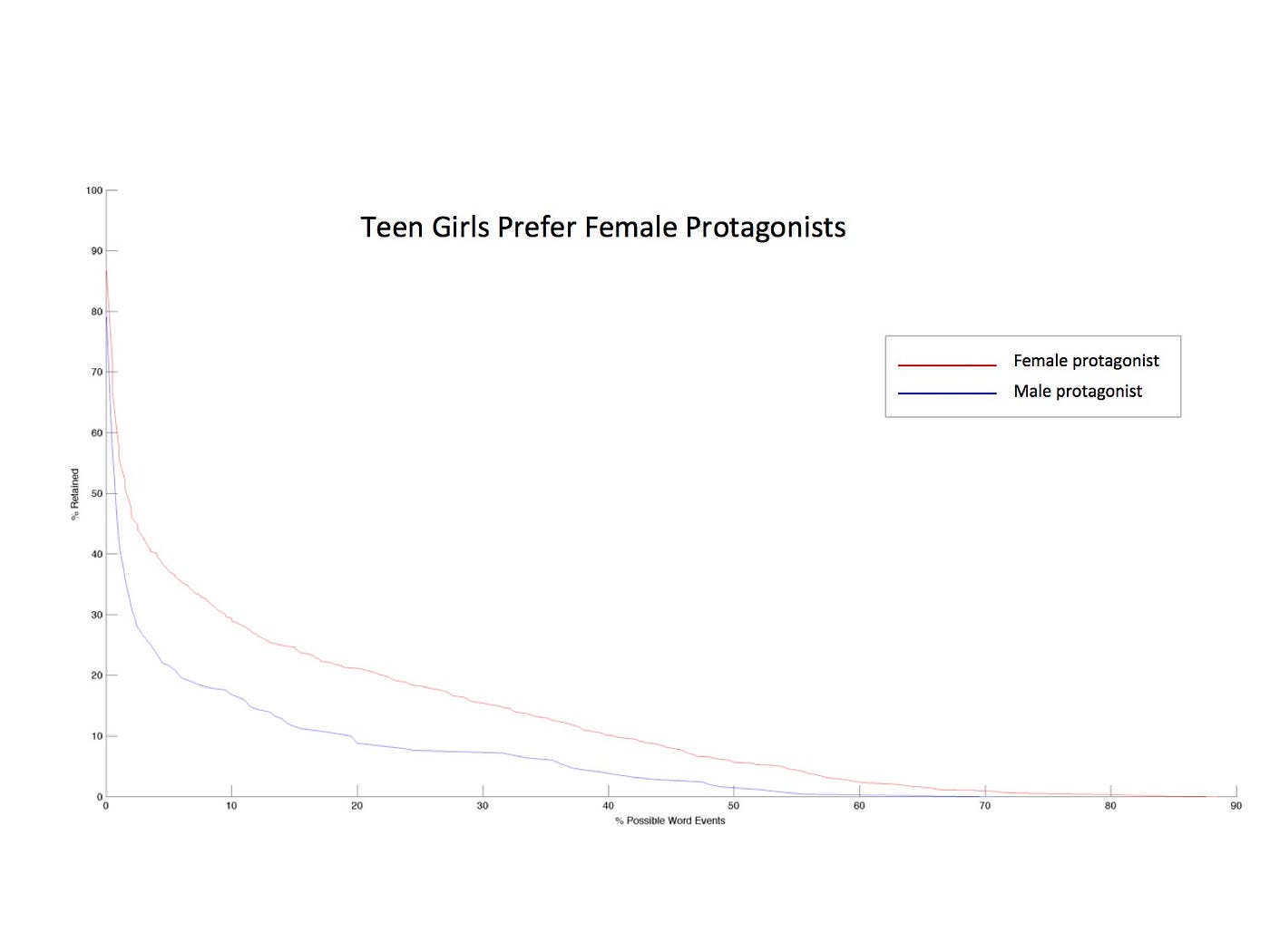
The Claiming
Eventually, an interesting design emerged from our tests.
The completion rates on a five-infinitesimal read varied, depending on the story nosotros were testing. In some cases, only 5% of people would read to the end of a 5-minute extract. In other case, x% or 15% of people did.
But there seemed to exist a ceiling in the completion rate. Of all the stories we tested, in the very best cases only about a third of readers would make it all the way to the terminate. That's on a five-infinitesimal read.
In other words, the majority of teen readers were not even completing the first v minutes of best-selling YA novels (when reading them on a phone).
This was depressing. Maybe reading really was dying.
But we took it equally a claiming. We asked ourselves: can we come up up with a format innovation that makes reading fiction more than engaging for teenagers?
How can we become a majority of teens to requite us their undivided attention…for v minutes…on their phones…to read…fiction?
That's when we had our epiphany.
The Aha Moment
We started initially by testing comic-book inspired ideas. We thought that if we told more of the story through images, teens might detect reading more engaging.
We tested many iterations, but zip moved the needle. No matter what we tried, reader date was still bottomless.
Then we had an off-the-wall idea to test a story written equally a text message conversation between the characters. Information technology was i,000 words, or a five-minute read, the same length as everything else we had tested thus far.
The starting time chat story we tested had staggering results. Almost every teenager who started reading our chat story finished it in 1 session.
We thought it was an error. We had never run an a/b examination before with this magnitude of a modify. So we tested it again. And nosotros got the same results.
That was the calorie-free bulb moment.
Nosotros launched Hooked four months later.
Getting To Traction
We launched an MVP (minimum feasible product) of Hooked in tardily September, 2015.
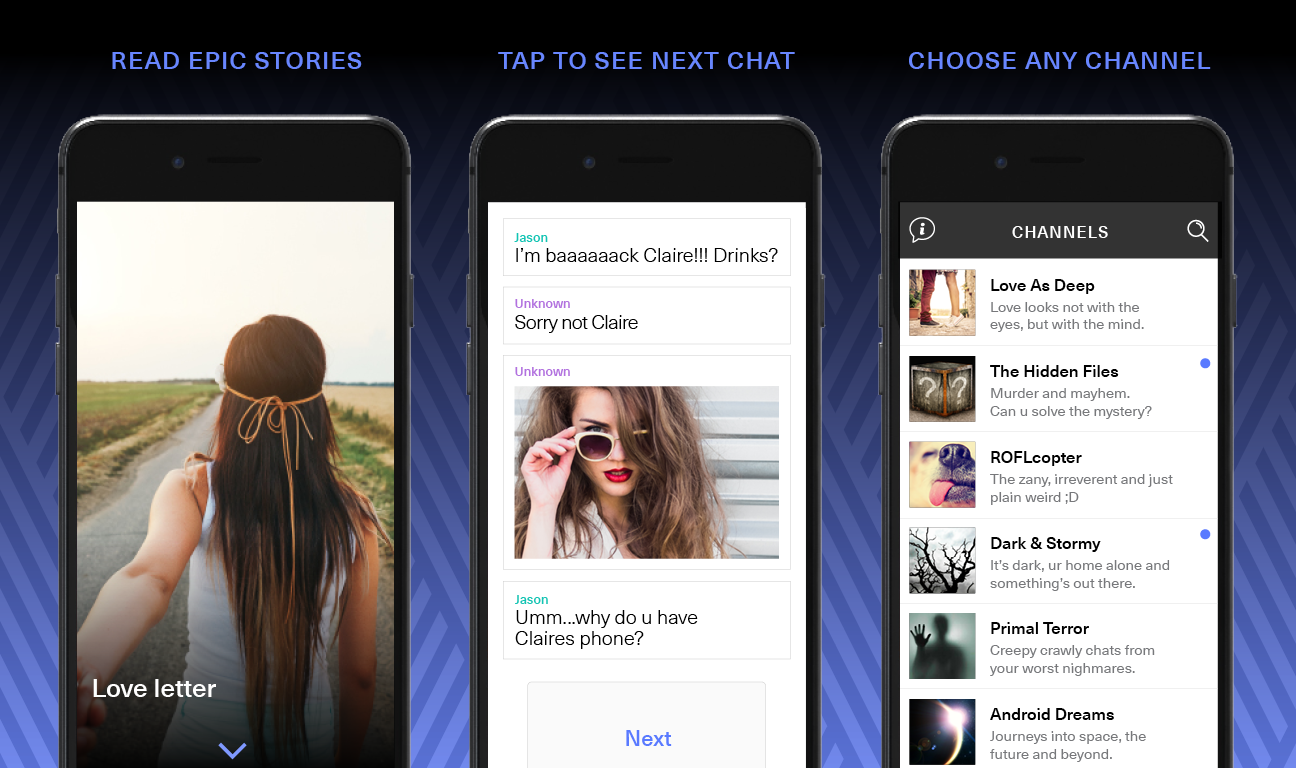
Nosotros spent the adjacent year iterating, talking to our early readers, edifice product, working with undiscovered authors, and developing our catalog of chat stories.
Over fourth dimension, we added social features, including the ability for users to write their ain stories.
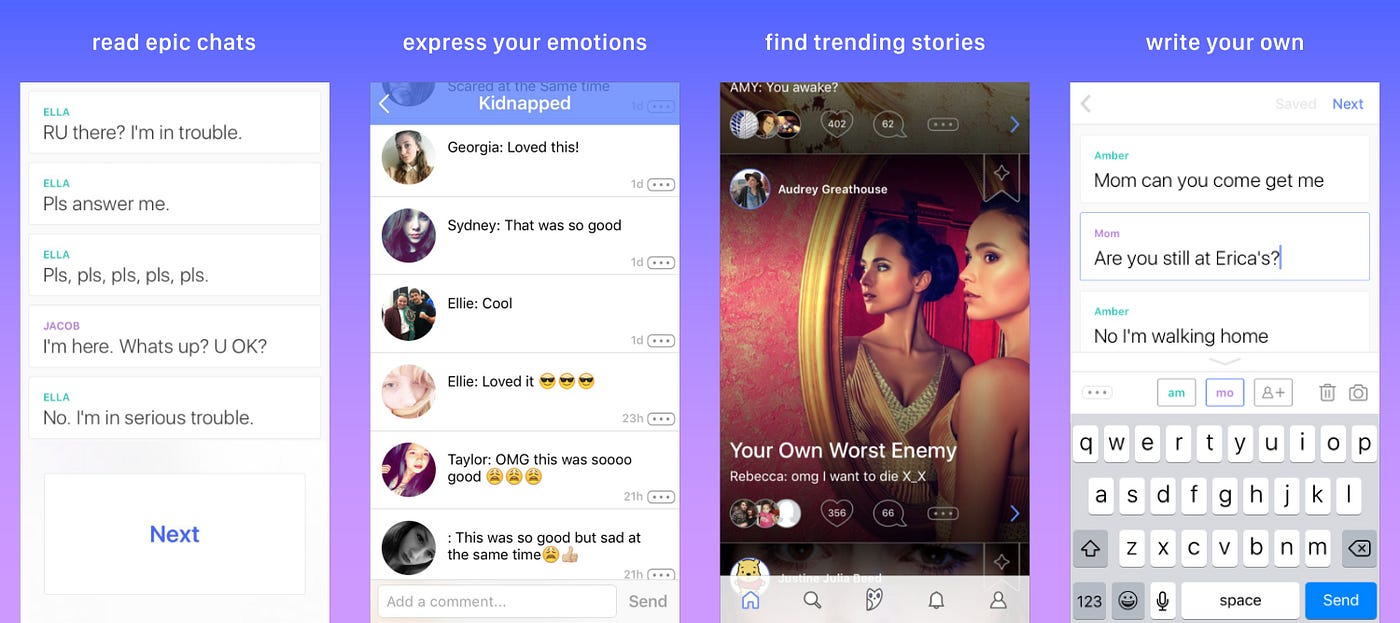
We started to get some press coverage, in BusinessInsider, TechCrunch, Wired, and LATimes.
And slowly, slowly, things started to click.
In September, 2016, Hooked began rising up the charts.
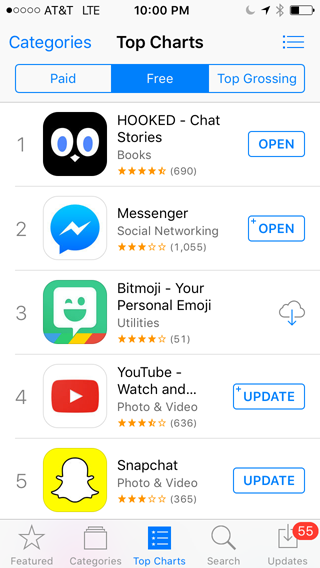
On December one, 2016, Hooked striking the #one spot in the App Shop.
Since then, Hooked has consistently been a Elevation 100 app in the U.S. App Shop, and information technology's hit the #1 spot once more twice, including this past weekend. Nosotros've as well striking the #1 spot in several other countries, including French republic, Canada, U.K., and Mexico.
Ten million young readers have installed Hooked in the past six months, collectively reading over ten billion fictional text messages in the app during that fourth dimension. Hooked users accept also written over a 1000000 conversation stories of their own, straight from their phones.
Our stories still have remarkably loftier completion rates, and our most popular ones, like The Watcher — a YA thriller told as a nighttime, modern twenty-four hour period fairytale — have amassed avid fanbases.
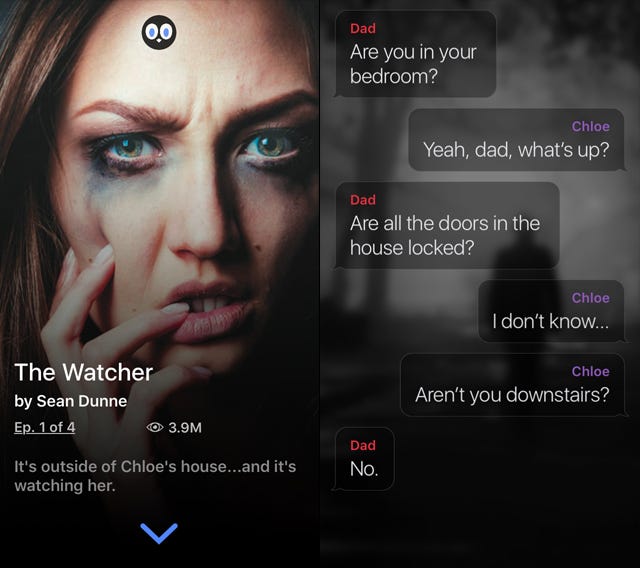
Just A Dumb Fad?
Understandably, we have encountered a high caste of skepticism about what nosotros're doing.
Although nosotros have been fortunate enough to concenter some of the best investors in Silicon Valley and Hollywood, there are notwithstanding many people who think chat fiction is silly. Others fright that we are destroying reading.
But to enquire "is chat fiction a fad?" is to await at things likewise narrowly.
Art evolves with technology.
Think almost movies, for case. The first movies always made were substantially just theatre, captured on motion picture. But every bit directors, writers, actors and cameramen became more adept with recording technology, the manner in which we tell stories fundamentally changed. Technology made us more effective at storytelling.
The same volition happen with mobile phones. Equally nosotros spend more and more than time consuming media on phones, the way in which nosotros tell stories volition modify, to reverberate our evolving behavior. To reflect our evolving lives.
Chat fiction is one footstep in that progression.
As the category has grown, several copycats of Hooked accept emerged. Although these initial products are merely clones of Hooked, they are making one thing clear: chat fiction has come of age.
Hooked will not be the just i telling stories in this format, and that's a good thing.
It means nosotros are succeeding in our mission: getting teenagers to read more fiction.
Rather than destroy reading, Hooked makes reading engaging for a broad audience. Nosotros've heard from many teens who say they hate reading books, simply they honey reading in Hooked. It'due south a gateway drug.
And nosotros're only getting started. What you lot run across in Hooked today is but a glimpse of the future of storytelling.
The greatest stories e'er told started with a i,000 words. Ours is just showtime.
Source: https://medium.com/@prernagupta/how-we-got-10-million-teens-to-read-fiction-on-their-phones-19a2a475084c
0 Response to "Teens Fiction App Where Teen Upload Stories"
Post a Comment